As travel companies strive to expand their reach, establishing a robust online presence is not an option—it's a necessity. One of the ways to achieve this is to create a travel affiliate program—a mutually beneficial partnership between businesses and affiliates that opens up new avenues for revenue generation. Affiliate marketing has an undeniable influence in the digital landscape, with the travel and leisure sector making up 16 percent of the total revenue.
In this article, we’ll explain the core principles of travel affiliate marketing and take you through the steps of building an effective affiliate program, all while providing real-world examples of how other travel companies run their programs.
What is a travel affiliate program?
Affiliate marketing is an advertising practice in which businesses compensate third-party companies or individuals (affiliates) for driving traffic or sales to the business's products or services. Affiliates earn a commission for each lead or sale generated through their marketing efforts. You’ve probably seen affiliate marketing at work—for example, a link to some product embedded in a social media post. In this case, the author of the post is likely an affiliate getting paid by the company offering the product.
This section will dive into the principles of travel affiliate marketing, explaining the key components and highlighting its primary advantages to businesses.
How travel affiliate programs work
To understand the intricacies of travel affiliate marketing, let's break down the roles of each player.
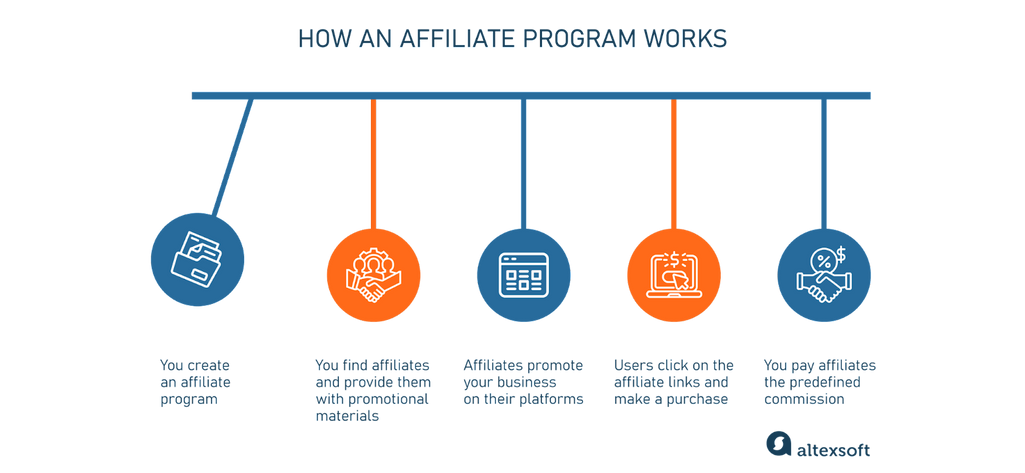
The travel company acts as the merchant, offering various products or services, such as rental cars, hotel rooms, airfares, travel packages, etc. Merchants are responsible for establishing and managing the affiliate program. The entire process encompasses the following tasks:
- defining the program objectives,
- selecting affiliates and connecting with them,
- setting commission structures,
- outlining terms and conditions,
- educating affiliates and providing them with marketing materials,
- choosing the way of managing the program, and
- choosing the way of tracking referrals.
We’ll discuss each stage further in more detail.
Affiliates are third-party companies or individuals who join the merchant's affiliate program, helping to extend the business' reach to new audiences. Their primary role is to promote the products or services through various online channels, including personal websites, blogs, social media, and email marketing. Through these platforms, affiliates publish promotional content, such as reviews or articles, aiming to capture the attention of potential customers and drive them toward the products or services they are promoting.
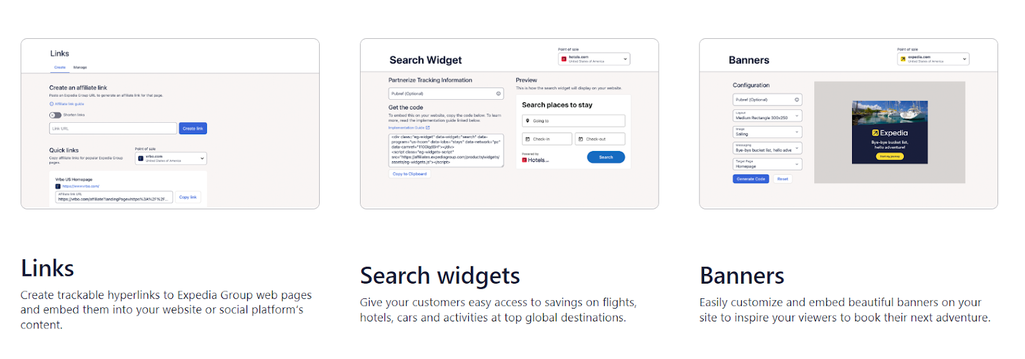
Types of promotional assets that Expedia Group Affiliate Program offers to its partners. Source: Expedia
In the content, affiliates integrate promotional assets provided by the travel company, which can be:
- text links that allow users to visit the travel company’s website,
- widgets enabling searches for products or services without leaving the affiliate’s platform, or
- clickable banners that typically include visually appealing images, some text, and a button that redirects users to the merchant's website.
Affiliates are usually trusted figures within their specific niches, and in the context of travel, they may be travel bloggers, influencers, travel agencies, or independent agents.
Potential customers are the users who discover and engage with the travel company's products or services through the affiliate-promoted content. Interested customers interact with affiliate links, widgets, or banners and engage with the travel company's offerings by signing up for newsletters, making bookings, or simply visiting the website.
The advantages of travel affiliate programs
So how can this marketing approach benefit your travel business?
Increased brand exposure. When companies collaborate with affiliates, they gain visibility in the affiliate's audience. These partnerships allow businesses to diversify their marketing channels. Moreover, the backlinks generated through affiliate promotions act as endorsements and signal to search engines that the company is reputable and authoritative, ultimately contributing to improved rankings in search results.
Cost-effective marketing. Unlike traditional advertising methods that often require upfront payments without guaranteed returns, affiliate marketing operates on a performance-based model. It means that businesses only compensate affiliates for actual results after bringing in sales, leads, or other predefined actions. This model mitigates the financial risk, making it accessible to companies of various sizes.
Affiliates are far more trusted than ads. Today's consumers actively seek peer-driven content, evidenced by 95.1 percent of travelers checking at least seven reviews before booking a hotel. In any industry where authority and authenticity carry significant weight, affiliates play a substantial role as they have established credibility and a loyal following. Travelers tend to place more trust in credible advisors rather than in random advertisements.
How to create a travel affiliate program
In this section, we will break down all the steps a business must take to create a successful travel affiliate program.
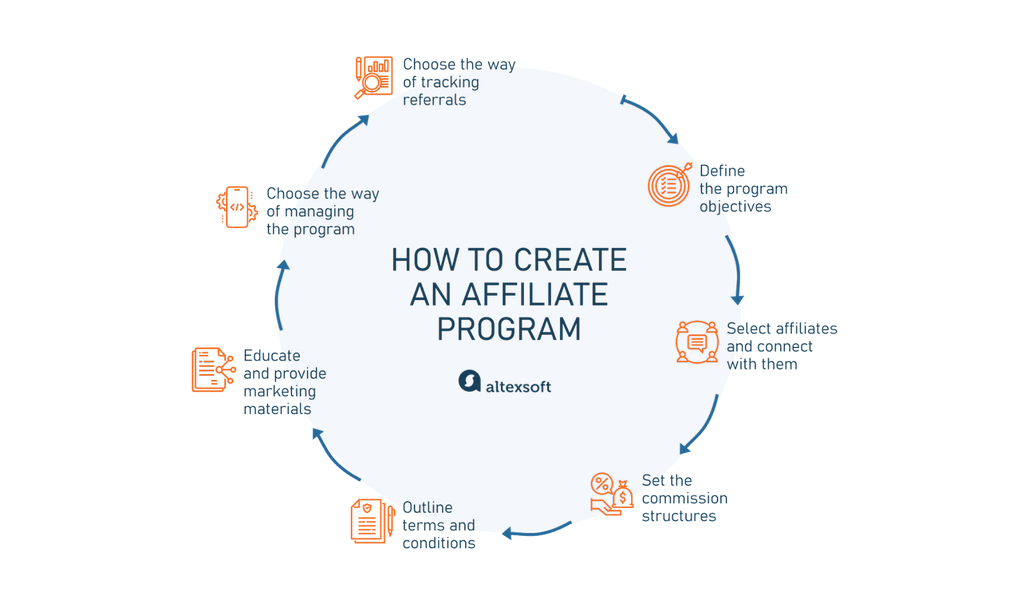
You will learn how to define program objectives, build and maintain relationships with affiliates, outline program policies, and choose the right tools to manage your program.
Define the program objectives
Defining program objectives is foundational in creating a travel affiliate program. This involves clearly outlining the results you want to achieve and how you will measure the program's success. For a better idea of what the objectives might be, here are some questions to answer:
- What specific outcomes do you hope to see as a result of the travel affiliate program?
- Which key performance indicators (KPIs) will best reflect the program's success in achieving its goals?
- How does the travel affiliate program fit into the long-term vision and growth strategy of your business?
- Which products or services do you want to include in the program?
- What type of travelers do you want to attract?
Answering these questions will allow you to navigate the complexities of the program with a clear vision, informing strategic decisions related to the following stages.
Select affiliates and connect with them
The second step in creating a successful travel affiliate program involves identifying potential affiliates and reaching out to them. At this stage, you establish a network of partners who will promote your travel offerings. The program's success depends on building strong relationships with affiliates who can reach and influence your target audience.
You can identify them yourself or by using affiliate networks. The first option involves connecting with your existing network, including business contacts, industry associates, and customers. You can also look for content creators and businesses related to travel using social media. When contacting them, you should present your brand and share the program details.
Affiliate networks are platforms that act as intermediaries and connect merchants with affiliates. This method streamlines the recruitment process, providing access to an established pool of potential partners with a proven track record in promoting travel businesses.
The most popular affiliate networks are Travelpayouts, Rakuten Advertising, KAYAK Affiliate Network, Awin, and CJ Affiliate. Below, we provide a concise comparison table with key information about each affiliate network.
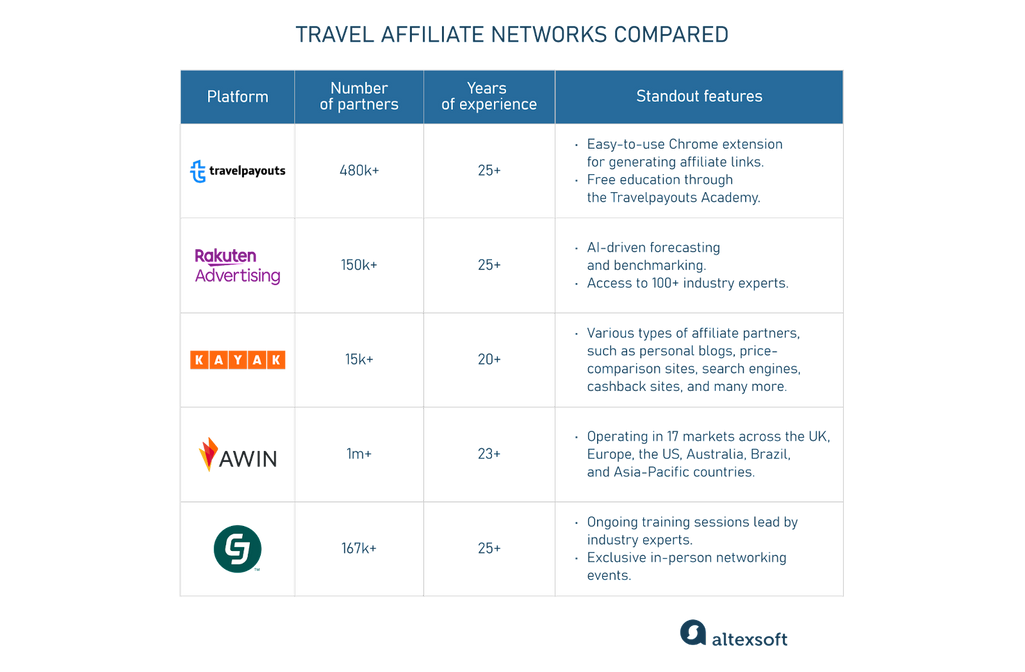
When selecting potential affiliates, here are some factors to consider:
- the size of their following or the client base,
- the level of engagement the affiliate has with their audience,
- their audience’s demographics,
- the quality and relevance of the affiliate's content, and
- their experience in promoting travel-related products or services.
For example, Skyscanner has clear requirements for its affiliates.
- The website has HTTPS Status.
- The website’s traffic volume is greater than 5,000 unique visitors per month.
- The website has up-to-date travel content.
- A social media/influencer site must have more than 1,000 followers and up-to-date, travel-related content.
Keep in mind that your affiliates will not merely promote your travel offerings. They'll represent your brand identity and convey the values, contributing to your visibility in the market.
Set commission structures
Setting commission structures involves defining the terms under which affiliates will be compensated for driving traffic, leads, or sales to your business. Commissions serve as critical incentives for affiliates, influencing their motivation to promote a business. Offering attractive commissions helps draw in high-quality affiliates and gives the program a competitive edge in the affiliate marketing landscape.
Different affiliates may prefer different commission models. You can pay a fixed percentage of the total booking value for each successful sale generated through a referral or pay a fixed commission. Businesses can also opt for hybrid models, for example, combining a flat fee for each lead generated and a percentage commission for actual bookings.
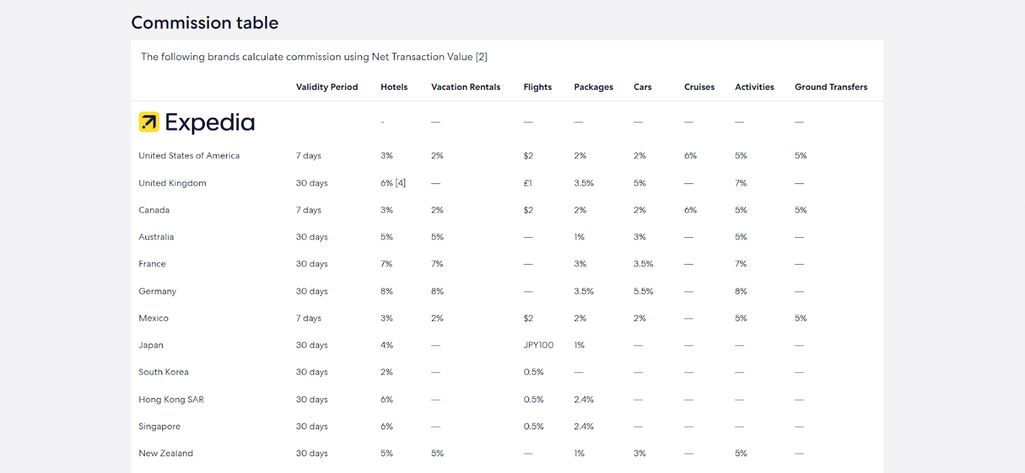
Commission table of Expedia Affiliate Program. Source: Key Commercial Terms
For instance, the commission rates of Expedia’s affiliate program differ by brand site, travel product, and country. You may pay a different commission for the same hotel in the USA if a traveler booked it on Expedia.com versus Expedia.co.uk.
Additionally, implementing tiered commission structures based on performance levels can motivate affiliates to continuously improve their promotional efforts. For example, you can start with a 5 percent commission for up to 20 monthly sales. Affiliates can progress to the next tier, earning higher commissions as they generate more sales, such as 7 percent for up to 40 sales, 10 percent for up to 60 sales, and so on.
Agoda’s affiliate program is a prime example of using tiered commission structures. The more completed bookings their affiliates generate each month, the higher the percentage of those bookings Agoda pays them for that month. Such commission structures reward long-term partnerships and foster affiliate loyalty.
Understanding your customer lifetime value (CLTV) will help you determine a sustainable commission rate for your business. CLTV estimates how much a company receives from a customer during the entire engagement length before this customer churns. To ensure profitability, the affiliate commission rate must be significantly below your CLTV.

You multiply the overall number of purchase transactions you receive per year, the average value of these transactions, your average gross margin per purchase in percent, and the average number of years your travelers stick with you.
Another tip is to analyze the rates your competitors offer in their affiliate programs and then establish your own commission that will be competitive and appealing to potential affiliates.
Clearly outline terms and conditions
Outlining terms and conditions is a critical step that involves defining the rules and responsibilities governing the relationship between your business and its affiliates. Clarity in terms and conditions is essential for managing expectations, ensuring compliance, and avoiding misunderstandings.
Your affiliate program policy should address the following aspects:
- what travel offerings you include in the program,
- commission structure and payment schedules,
- branding guidelines and the use of marketing materials,
- prohibited marketing practices,
- how the business and affiliates will communicate, and
- the conditions under which you can terminate or suspend an affiliate from the program.
By clearly outlining terms and conditions, businesses provide a solid foundation for a successful affiliate program, fostering a transparent and compliant partnership with affiliates.
Educate your affiliates and provide marketing materials
It is crucial to equip your affiliates with the necessary educational resources to market your company effectively. This ensures that affiliates understand your brand, target audience, key selling points, and other specific aspects of your travel business. You can also provide tips on effective marketing strategies and target audience analysis. Keeping affiliates informed and engaged fosters a sense of community and commitment.
You can do it by:
- hosting webinars or interactive workshops,
- providing detailed tutorials to educate about your company, and/or
- sending regular newsletters with program updates and marketing tips.
For example, companies like KAYAK and GetYourGuide state that they provide support and educational resources for their affiliates from the start of their partnerships.
Another crucial merchant responsibility is to provide standardized marketing materials. This way, affiliates represent the brand consistently, maintaining a cohesive and professional image across various promotional channels.
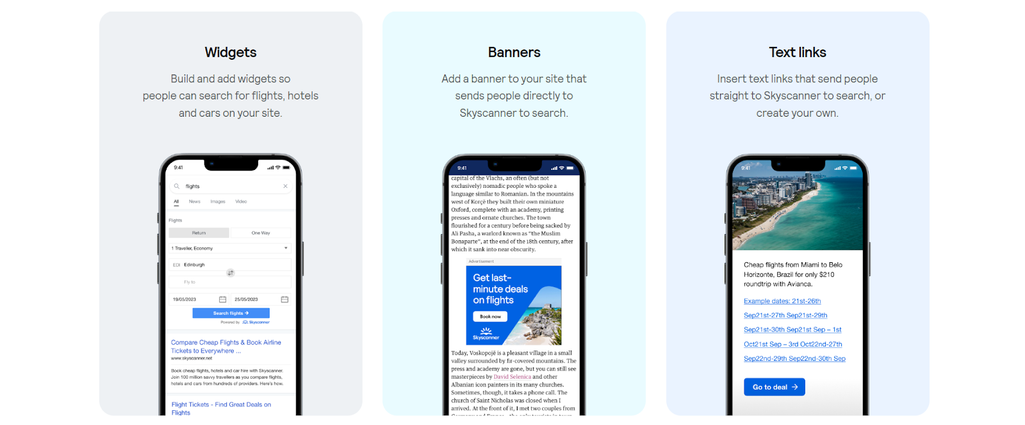
Promotional assets that Skyscanner offers to its affiliates. Source: Skyscanner
Ready-to-use marketing materials streamline the content creation process for affiliates, including
- high-quality banners and images with information about your travel offerings;
- promotional copy and messaging;
- customizable templates for email campaigns, social media posts, or blog content;
- list of keywords and meta tags for search engine optimization (SEO).
You should also be mindful of the marketing channels your affiliates plan to use. For example, if they focus on promoting your business through blog articles, it's important to acknowledge this strategy and help them excel in that particular channel.
Choose the way of managing your program
Choosing how to manage a travel affiliate program determines how the program will function and how affiliates will be recruited, tracked, and compensated. Two main methods for managing a travel affiliate program are running it in-house using an affiliate tracking platform or joining an affiliate network.
In-house management means the business directly oversees and operates the affiliate program. An affiliate app or software tracks affiliate activities and manages commissions and reporting. Companies can use a third-party platform (like Affise, Binom, and Voluum) or build their own, which is the costlier option.
In-house management gives businesses more control over the program's operations, allowing them to customize commission structures, track clicks attributed to each affiliate, and maintain direct communication.
Joining an affiliate network involves partnering with a third-party company. As we said before, affiliate networks provide access to a pool of affiliates, simplifying the recruitment process. They also take on primary tasks like managing commission payments, tracking, and reporting. For example, both Tripadvisor and Booking.com use the same affiliate networks for their programs—Awin and CJ Affiliate.
Using an affiliate app is more suitable for businesses with specific customization needs and a desire for direct control. Affiliate networks are better for companies looking for intermediaries for a quick and broader affiliate reach without extensive in-house management. Some businesses may even choose a hybrid approach, combining some elements from both methods.
Choose the way of tracking referrals
Choosing how to track referrals means deciding how to monitor and attribute the traffic, leads, or sales generated by affiliates. Let's look at some of the most common tracking methods.
Promo codes. When affiliates are given unique promo codes, their audience can use them when booking. When a sale is made using a specific promo code, the affiliate associated with that code is credited. Promo codes also serve as an additional incentive for customers who may receive discounts related to the code.
Tracking links. With this method, each affiliate is assigned a unique tracking link that contains parameters identifying them. When users click on this link, the parameters are passed to the destination website, allowing the merchant to attribute the referral to the correct affiliate.
Cookies. Cookies are small pieces of text sent to your browser by a website you visit. They help that website remember information about your interactions. In affiliate marketing, cookies track a user's journey from the affiliate's channel to the merchant's website.
When a user clicks on an affiliate link, a unique tracking cookie is stored on their browser. The cookie contains information identifying the affiliate and the cookie duration, which is how long the affiliate program will attribute the purchases to an affiliate's cookie. For example, Agoda’s affiliate program has a cookie duration of only one day, while Hostelworld’s is 30 days. In the latter case, if a traveler clicks on an affiliate link but completes a booking after 30 days, the affiliate associated with the initial click will not receive a commission for the sale.

Sub-ID tracking. Sub-IDs are additional parameters you can add to the end of the tracking link. Unlike a regular tracking link that typically identifies the merchant and the affiliate, Sub-IDs offer a more detailed categorization and analysis. They can include details such as the website the user came from, specify the particular call to action that brought the user (buttons or text links), pinpoint the user's geographic location, and more.
Accurate referral tracking ensures that affiliates are properly credited for the traffic they drive and the resulting conversions. This is essential for fair compensation and maintaining trust in the program.
Continuous optimization of travel affiliate programs
Now that we've explored the intricacies and creation processes of travel affiliate programs, let's discuss how to promote their long-term success. As consumer behavior and industry trends evolve, conducting ongoing performance analysis and making regular updates will ensure your program's relevance and competitiveness.
Evaluating the program's effectiveness means assessing how well your program is doing against the measurable goals you set out earlier. The process includes tracking KPIs and using data-driven insights to adjust the program. For example, businesses can identify the highest performing affiliates, most successful promotional channels, and most effective marketing tactics, allowing them to allocate resources strategically.
The ultimate goal is to find out what resonates best with your audience and what generates the most conversions. You can implement testing to compare different versions of your campaigns and measure their performance. This iterative analysis, adjustment, and improvement process is essential for staying competitive in the dynamic landscape of travel affiliate marketing.

